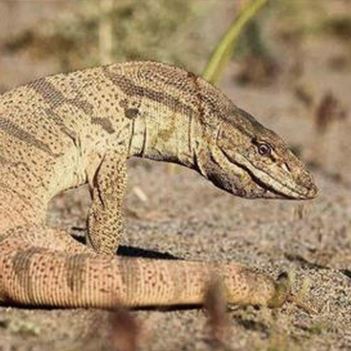Monitor lizards are lizards in the genus Varanus, the only extant genus in the family Varanidae. They are native to Africa, Asia, and Oceania, and one species is also found in south America as an invasive species.[1] About 80 species are recognized.
Monitor lizards have long necks, powerful tails and claws, and well-developed limbs. The adult length of extant species ranges from 20 cm (7.9 in) in some species such as Varanus sparnus, to over 3 m (10 ft) in the case of the Komodo dragon, though the extinct megalania (Varanus priscus) may have reached lengths of more than 7 m (23 ft). Most monitor species are terrestrial, but many are also arboreal or semiaquatic. While most monitor lizards are carnivorous, eating smaller reptiles, fish, birds, insects, small mammals, and eggs, a few species also eat fruit and vegetation.
The generic name Varanus is derived from the Arabic word ورل waral [Standard Arabic] / ورر warar [colloquially] / ورن waran [colloquially], from a common Semitic root ouran, waran, warar or waral, meaning "lizard beast".
In English, they are known as "monitors" or "monitor lizards". The earlier term "monitory lizard" became rare by about 1920. The name may have been suggested by the occasional habit of varanids to stand on their two hind legs and to appear to "monitor", or perhaps from their supposed habit of "warning people of the approach of venomous animals".But all of these explanations for the name "monitor" postdate Linnaeus giving the scientific name Lacerta monitor to the Nile monitor in 1758, which may have been based on a mistaken idea by Linnaeus that the German word Waran (borrowed from Arabic) was connected to warnen (to warn), leading him to incorrectly Latinize it as monitor ..

